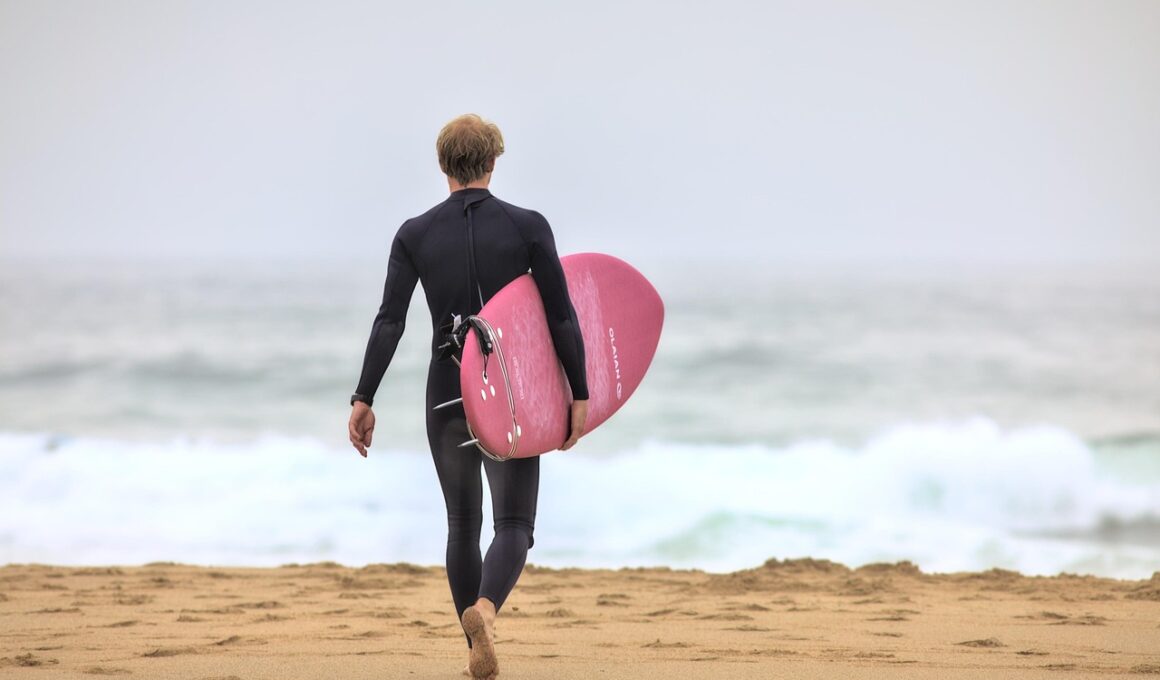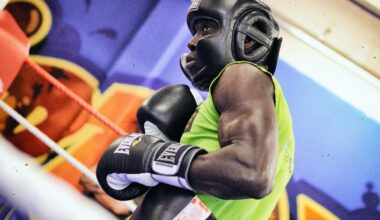Surfboard Selection and Customization for Different Skill Levels
Choosing the right surfboard is crucial for any surfer, whether a novice or an expert. The selection process begins with identifying the skill level of the surfer. Beginners often require boards that provide stability and ease of paddling, while experienced surfers may prefer boards designed for speed and maneuverability. Factors such as board width, length, and volume must be considered carefully to optimize performance. When selecting a surfboard, beginners should prioritize boards with a wider outline, as it promotes better balance in the water. For more advanced surfers, a shorter and thinner board allows for sharper turns. Ultimately, understanding personal skill level aids in making accurate selections. Researching different surfboard materials and shapes, including shortboards, longboards, and fish boards, can contribute to enhancing the surfing experience. Depending on individual preferences, customization options may also be explored, allowing surfers to create boards tailored to their unique style. Assessing local surf conditions is essential, enabling surfers to choose boards compatible with different wave types, enriching their overall surfing experience significantly.
In discussing surfboard design, one must focus on the material composition. Surfboards can be crafted from various materials, each impacting performance in different ways. For instance, traditional polyurethane boards are popular for their performance characteristics and durability, but they come with a certain weight. On the other hand, epoxy boards are lighter, offering more buoyancy but often sacrificing some responsiveness in water. These variations imply that both beginners and experienced surfers have distinct preferences regarding weight and flexibility. In terms of shape, wider noses and tails can enhance stability for new surfers, while thinner designs can promote better aerial maneuvers for seasoned surfers. Furthermore, customization plays a pivotal role in optimizing user experience, as individuals may choose specific color schemes or artwork that reflects their personality. Collaborating with experienced shapers is essential in acquiring boards built to suit varied predilections, improving surfing versatility. An informed approach to choosing the right surfboard based on these criteria ensures that surfers connect with their equipment, ultimately giving them more enjoyment and confidence when they hit the waves. Educating oneself about these factors is essential for overall surfing improvement.
Surfboard Volume and Its Importance
Another critical factor in surfboard selection is volume, which determines how buoyant and stable the board is in the water. Surfboards are typically designed with varying volumes, accommodating surfers of differing skill levels and sizes. Beginners should aim for boards with higher volume, as they provide greater stability while paddling and help to catch waves more easily. The higher volume also contributes to a smoother ride, regardless of wave conditions. In contrast, more experienced surfers may prefer lower-volume boards, allowing for advanced maneuvers and better responsiveness. A well-sized board typically aids in smoother transitions, especially during challenging or fast-moving conditions. Riders must assess their weight and skill level, as the appropriate volume selection directly impacts performance and progression. Hence, consulting volume charts or collaborating with surf instructors can offer guidance during the selection process. Ultimately, understanding how surfboard volume affects overall surfing performance is essential for making informed choices. Finding the right volume in accordance with individual skills will significantly lead to improved confidence, enabling a more enjoyable surfing experience.
Customization options also extend beyond basic selections; they encompass fin setups, leash attachments, and tail shapes. Each of these features modifies the performance of the board in various ways. For example, a thruster setup with three fins provides enhanced control, perfect for more advanced surfers tackling demanding waves. In contrast, a single fin setup is often recommended for those seeking a classic approach to longboard surfing. Tails also play an essential role, with different shapes influencing how the board interacts with the wave—squash tails promote speed, while round tails enhance maneuverability. For surfers exploring their potential in different surfing styles, customizing these elements can significantly impact their performance and comfort. Understanding the functional benefits of various changes helps surfers make the right decisions, ensuring they match their board setups with their unique preferences. Emphasizing collaboration with skilled professionals for custom adjustments results in boards that improve surfing abilities. Engaging in conversations with expert shapers or experience surfers can provide valuable insights into which configurations will suit personal surfing goals. All these factors contribute to a robust surfing experience tailored to individual needs.
Wave Conditions and Surfboard Compatibility
Wave conditions substantially dictate the kind of surfboard suitable for different skill levels. Beginners should ideally start with softer waves, making longboards a favored option as they offer stability in smaller conditions. Longboards provide ample paddle power, improving wave-catching experiences for newcomers. Conversely, when conditions involve bigger waves, shortboards take precedence, as they allow for quicker turns and sharper maneuvers, catering to more advanced surfers. Understanding the beach dynamics, including wave size and break type, illustrates how different boards perform under varied conditions. This understanding also briefly affects materials, as durable constructions can withstand harsher impacts. Additionally, paying attention to the type of fins selected is vital for wave conditions. Surfers must ensure proper fin setups aligned with current surf styles, evaluating how each option responds to local wave patterns. Considering these concerns ultimately leads to a better surfing experience. New surfers benefit immensely when taking time to identify appropriate boards based on the waves they plan to tackle. Selecting the ideal board according to local environmental factors contributes significantly to surfers achieving long-term success.
A vital aspect of advancing in surfing is understanding the balance between personal style and board specifications. Personal aesthetics play a crucial role in a surfer’s performance and enjoyment. Customizing graphics, colors, and finishes fosters individuality and can enhance connection with the board. Riders often feel a sense of pride when showcasing their unique board designs, which can positively impact performance. With customization being more accessible today, surfers may choose from various surfboard templates or consult professionals to create specific requirements. Furthermore, enhancing personal expression leads to a newfound enjoyment of surfing as a sport. When users prioritize style alongside function, they tap into a larger experience on the water while developing improved confidence over time. Each surf session not only becomes about improved skill but also about expressing one’s identity. Connecting artistry with technical specifications contributes significantly to motivating growth within the sport. As surfers evolve beyond basic selections, they find empowerment in celebrating their creativity and performance as equals. Over time, the improved relationship between the surfer and board ensures longevity in surfing, solidifying a deep-rooted bond.
Conclusion
In conclusion, selecting the right surfboard and customizing it based on various elements can greatly impact an individual’s surfing journey. With consideration for skill level, physical attributes, and environmental conditions, board selection becomes a more informed and tailored process. Whether individuals are newcomers seeking the perfect balance of stability or intermediate surfers pushing their boundaries, this guide helps navigate the intricacies of surfboard choices. Customization stands as a critical component in both personal expression and enhanced performance. Riders are encouraged to explore the best combinations of shapes, sizes, volumes, and materials to discover what aligns with their core surfing experiences. Ultimately, each surfer’s journey is unique, and realizing the various elements at play adds value to the learning process. For those eager to embark on the journey of surfing improvement, taking time to understand and customize the gear will lead to a rewarding experience in the water. The world of surfing is vast, and mastering the art of surfboard selection will ensure long-lasting enjoyment and progress.
Therefore, nurturing a love for surfing goes beyond just riding waves, as it embodies a deeper connection with the equipment utilized. Becoming familiar with aspects like surfboard specifications, customizing options, and compatibility with various conditions enhances the learning curve significantly. For beginners and experienced surfers alike, taking the time to comprehend these elements will immensely benefit their ability to grow and enjoy the sport. Knowledge sharing and collaboration with the surfing community can further facilitate this process, ensuring surfers stay updated on trends and innovations. By embracing proper surfboard selection and customization, surfers unlock the potential to build their unique paths in the water. It is this journey of continual learning and progress that sustains the love for surfing, encouraging ongoing participation. Engaging actively with the surf community also allows surfers to gather support and shared experiences. As waves roll in, so too does the opportunity to connect with others who share the passion. Navigating the nuances of surfboard selection is just the beginning of fostering a deeper love for surfing—one that runs profound for all involved.


